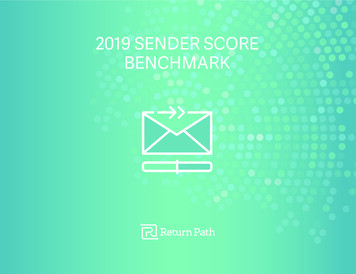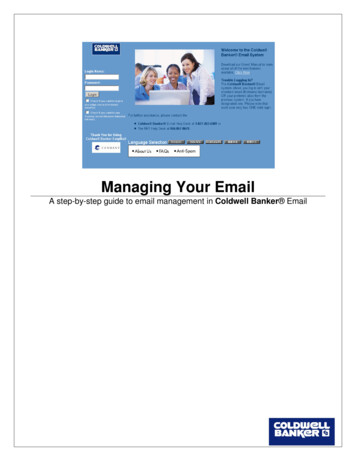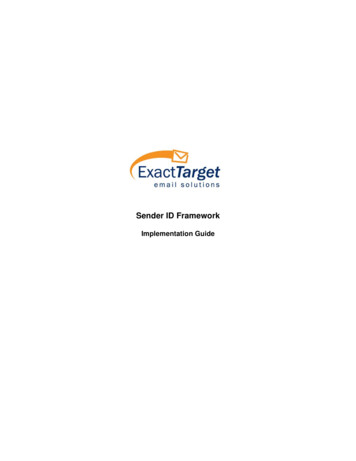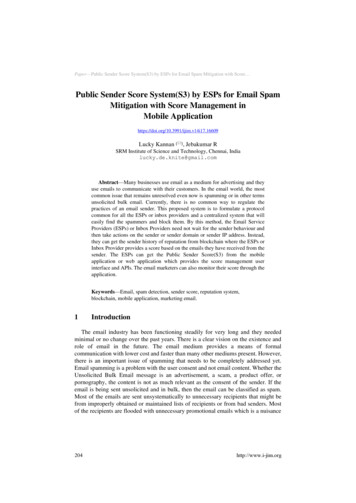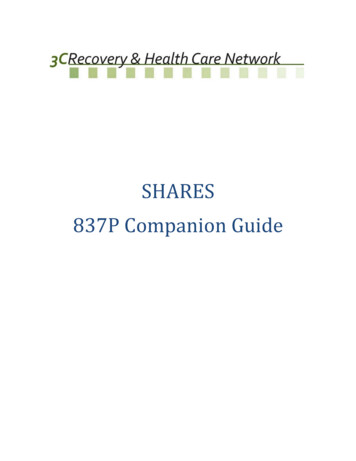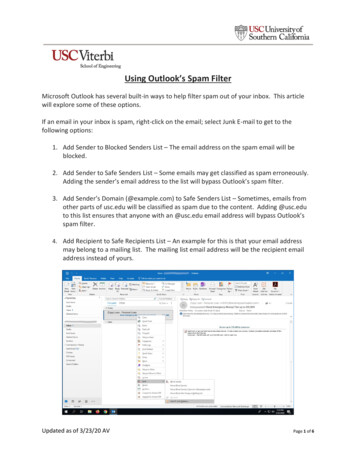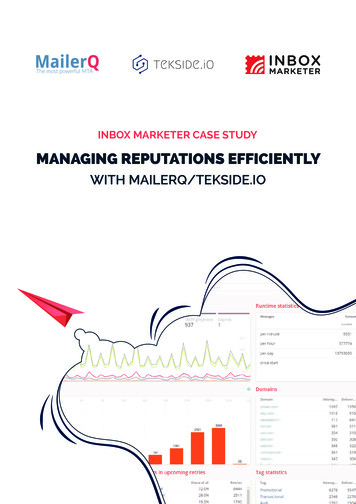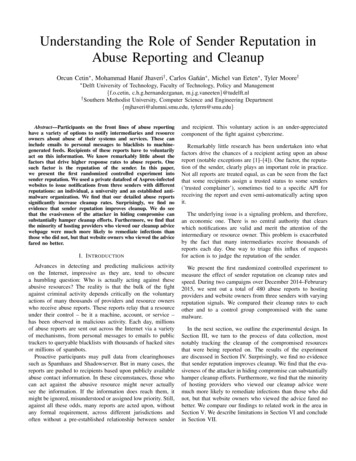
Transcription
Understanding the Role of Sender Reputation inAbuse Reporting and CleanupOrcun Cetin , Mohammad Hanif Jhaveri† , Carlos Gañán , Michel van Eeten , Tyler Moore† DelftUniversity of Technology, Faculty of Technology, Policy and Management{f.o.cetin, c.h.g.hernandezganan, m.j.g.vaneeten}@tudelft.nl† Southern Methodist University, Computer Science and Engineering Department{mjhaveri@alumni.smu.edu, tylerm@smu.edu}Abstract—Participants on the front lines of abuse reportinghave a variety of options to notify intermediaries and resourceowners about abuse of their systems and services. These caninclude emails to personal messages to blacklists to machinegenerated feeds. Recipients of these reports have to voluntarilyact on this information. We know remarkably little about thefactors that drive higher response rates to abuse reports. Onesuch factor is the reputation of the sender. In this paper,we present the first randomized controlled experiment intosender reputation. We used a private datafeed of Asprox-infectedwebsites to issue notifications from three senders with differentreputations: an individual, a university and an established antimalware organization. We find that our detailed abuse reportssignificantly increase cleanup rates. Surprisingly, we find noevidence that sender reputation improves cleanup. We do seethat the evasiveness of the attacker in hiding compromise cansubstantially hamper cleanup efforts. Furthermore, we find thatthe minority of hosting providers who viewed our cleanup advicewebpage were much more likely to remediate infections thanthose who did not, but that website owners who viewed the advicefared no better.I. I NTRODUCTIONAdvances in detecting and predicting malicious activityon the Internet, impressive as they are, tend to obscurea humbling question: Who is actually acting against theseabusive resources? The reality is that the bulk of the fightagainst criminal activity depends critically on the voluntaryactions of many thousands of providers and resource ownerswho receive abuse reports. These reports relay that a resourceunder their control – be it a machine, account, or service –has been observed in malicious activity. Each day, millionsof abuse reports are sent out across the Internet via a varietyof mechanisms, from personal messages to emails to publictrackers to queryable blacklists with thousands of hacked sitesor millions of spambots.Proactive participants may pull data from clearinghousessuch as Spamhaus and Shadowserver. But in many cases, thereports are pushed to recipients based upon publicly availableabuse contact information. In these circumstances, those whocan act against the abusive resource might never actuallysee the information. If the information does reach them, itmight be ignored, misunderstood or assigned low priority. Still,against all these odds, many reports are acted upon, withoutany formal requirement, across different jurisdictions andoften without a pre-established relationship between senderand recipient. This voluntary action is an under-appreciatedcomponent of the fight against cybercrime.Remarkably little research has been undertaken into whatfactors drive the chances of a recipient acting upon an abusereport (notable exceptions are [1]–[4]). One factor, the reputation of the sender, clearly plays an important role in practice.Not all reports are treated equal, as can be seen from the factthat some recipients assign a trusted status to some senders(’trusted complainer’), sometimes tied to a specific API forreceiving the report and even semi-automatically acting uponit.The underlying issue is a signaling problem, and therefore,an economic one. There is no central authority that clearswhich notifications are valid and merit the attention of theintermediary or resource owner. This problem is exacerbatedby the fact that many intermediaries receive thousands ofreports each day. One way to triage this influx of requestsfor action is to judge the reputation of the sender.We present the first randomized controlled experiment tomeasure the effect of sender reputation on cleanup rates andspeed. During two campaigns over December 2014–Februrary2015, we sent out a total of 480 abuse reports to hostingproviders and website owners from three senders with varyingreputation signals. We compared their cleanup rates to eachother and to a control group compromised with the samemalware.In the next section, we outline the experimental design. InSection III, we turn to the process of data collection, mostnotably tracking the cleanup of the compromised resourcesthat were being reported on. The results of the experimentare discussed in Section IV. Surprisingly, we find no evidencethat sender reputation improves cleanup. We find that the evasiveness of the attacker in hiding compromise can substantiallyhamper cleanup efforts. Furthermore, we find that the minorityof hosting providers who viewed our cleanup advice weremuch more likely to remediate infections than those who didnot, but that website owners who viewed the advice fared nobetter. We compare our findings to related work in the area inSection V. We describe limitations in Section VI and concludein Section VII.
II. E XPERIMENTAL D ESIGNDoes sender reputation matter when notifying domain owners and their hosting providers with evidence that their website is compromised? We designed an experiment measuringcleanup rates as a result of abuse reports sent from threesenders with varying levels of reputation: an unknown individual, a university and StopBadware, a well-established nonprofit organization that fights malware in collaboration withindustry partners.The analysis and data collection started in December 2014and continued through the first week of February 2015 acrosstwo campaigns. Figure 1 illustrates the rules we applied to getthe experimental data set from the original feed.Get URLs fromproviderStillcompromised?noDiscardGather hostingand webmastercontactinformationHosting abuse orhelp desk contactfound?noDiscardRandomControlIndividual researcher(Low Reputation)Tracking the presence of themalicious sponsesEstablished antimalware organization(High Reputation)Tracking cleanupwebsite visitEvaluationFig. 1: Flow diagram of the progress through the phases ofour experimentA. Study Population and SamplingThe study population was derived from a raw daily feedof URLs serving malicious downloads originating from theAsprox botnet. This private source of abuse data was notshared with anyone else and free of any prior notificationattempts.From December 7th, 2014 until January 19th, 2015, wereceived a total of 7,013 infected URLs. We checked whetherthe site was indeed still compromised. In a handful of cases,cleanup or remediation seemed to have taken place already.If so, the URL was discarded. Next, we looked up abusecontact information for the hosting provider and the thedomain owner from WHOIS data. If we could not find anycontact information for the hosting provider (for example, ifthe WHOIS information was set to private), we discarded theURL. When we did not find any contact information for thedomain owner, we would use the RFC standard abuse e-mailaddress [5]. All in all, we discarded fewer than 10 URLs foreither no longer being compromised or the lack of an abusecontact for the hosting provider.From the remaining set, we took a random sample. Thiswas done each day that new URLs were being supplied to us.The daily feed fluctuated dramatically, with peaks of close toone thousand URLs and days with just a handful. Most days,we received between 50-100 URLs. From these, we took adaily random sample, typically of around 40 URLs. We couldnot include all URLs we received in the experiment becauseof a bottleneck further on in the process: tracking the up-timeof the compromised content (see Section III).To determine the total sample size, in other words howmany URLs we needed, we completed a power calculationfor the main outcome variable, cleanup rate. We estimatedpower for three levels: 80%, 85% and 90% and used a 5.65standard deviation based on prior studies [1]. Differences inmean sixteen-day cleanup time of about 0.84 days betweenconditions can be detected with 90% power in two-tailed testswith 95% confidence, based on a sample of 80 websites ineach treatment group. To ensure that the control has enoughstatistical power for baseline comparison across treatmentgroups, we set the control equal to all other treatment groupscombined. This resulted in a total sample size of 482 URLs.B. Treatment Groups & RationaleUsing a random number generator, we assigned URLs toa treatment condition or to the control group. The threetreatment conditions were sending an abuse report from anindividual researcher, a university and an established antimalware organization (see Table I). The report from theindividual researcher was designed to reflect a low reputationabuse notifier and was sent from a Gmail account. Theuniversity group was set up to reflect a medium reputationabuse notifier. Here, we used a functional e-mail addressfrom Delft University of Technology. The established antimalware organization was included as the sender with thehighest reputation. StopBadware generously provided us ane-mail account at their domain to send notifications on theirbehalf [6].As the randomization took place at a URL level, the domainowner and the hosting provider were assigned to the same
GroupDescriptionSample SizeCamp. 1Camp. 2E-mail AddressControlNo yIndividual internet researcherAcademic porter-tbm@tudelft.nl1762Established Antimalware OrganizationAnti-malwarenonprofit onaleBaseline to understand the natural rate ofcompromised host survivalIndividuals may send mixed signals, fromquality to motivationAcademic organizations may signal higherquality and research intentDedicated organizations may signal thehighest quality research and/or potentialcommercial enforcementTABLE I: Overview of each treatment grouptreatment group. The notified entities were, by nature of theintervention, not blinded.Once assigned, we completed a statistical analysis on keyattributes to ensure the assignments were comparable acrossgroups. The control group served as a baseline to understandthe natural survival rate of a compromise and was the only onenot to receive notifications. There was no difference among thetreatment groups other than the domain of the e-mail addressand the host of the cleanup content. We base this on studies [7]that indicate users perceive domains with certain top-levelextensions to have differing levels of authority in terms ofthe accuracy of information.C. Notification & Cleanup Support SiteThe abuse notifications were based on the best practicefor reporting malware URLs that has been developed byStopBadware [8]. The content included the malicious URL,a description of the Asprox malware, the IP address, date andtime of the malware detection and a detailed description of themalware behavior. Abuse notification sample for establishedanti-malware organization, university and individual internetresearcher are respectively presented in Appendix figure 11,12 and 13.We sent notifications to each treatment group during 12 daysin total. All treatment groups received an identical abuse notification, except for the sender e-mail address and the includedlink to a web page where we described cleanup advice forsites compromised by Asprox. The web page provided a briefguide explaining how to identify and remove Asprox malwareand backdoors from compromised websites. The page alsoincluded links to other websites for precautionary measuresto prevent the site from being compromised again. Figure14 in the Appendix, contains samples of the various cleanupwebsites shared in the e-mail notification for each of thetreatment groups.The webpage was hosted at different domains consistentwith each treatment condition. The individual researcher emailed a link to a free hosting webpage, the university to apage inside the official TU Delft website, and StopBadwareto a page on their official domain.Furthermore, each cleanup link contained a unique sevencharacter code allowing us to track which recipients clicked onthe link. In this way, we measure whether visiting the cleanuppage was associated with higher cleanup rates.To prevent biases because of the recipients’ varying abilitiesto receive the e-mail and view the webpage, we tested all thee-mail notifications across various e-mail services to ensurecorrect delivery and double-checked that the webpages werenot on any of the major blacklists.D. EvaluationWe evaluate the experiment based on the differences incleanup rates and median-time to cleanup across the varioustreatment groups relative to the control group. We also explorethe relationship between cleanup rates and other variables,such as visits to the cleanup advice page and the responsesof providers to our notifications.III. DATA C OLLECTIONTo perform the experiment designed in the previous section,we received assistance from an individual participating in theworking group analyzing and fighting the Asprox botnet. Hesupplied us with a private feed of URLs in use by Asprox.The URLs were captured via spamtraps and various honeypotservers located in Europe and the United States.The Asprox botnet was first detected in 2007. Since then,it has evolved several times. Currently it is mostly used forspam, phishing, the distribution of malware to increase thesize of its network, and for the delivery payload of pay-perinstall affiliates [9]. Asprox compromises websites by buildinga target list of vulnerable domains and then injects SQLcode that inserts a PHP script that will trigger the visitor todownload malware or redirect them to various phishing sites.Our URL feed contained both variations.A. Evolution of Asprox compromised sitesIn the course of our experiment, Asprox’s behavior changedas it went through two different attack campaigns (see Table II). From December 2014 until beginning of January 2015,the infected sites delivered a malicious file. After that, fromJanuary 2015 until February 2015, instead of delivering amalicious file, infected domains redirected visitors to an adfraud related site. Moreover, these two campaigns did notonly differ on the type of malicious behavior but also onthe countermeasures taken by the botnet against detection andremoval.During the first campaign, the botnet’s countermeasures included blacklisting of visitors to the compromised sites based
CampaignsStart DateEnd DateTypeCharacterCampaign 112/08/201412/26/2014MalwareCampaign 201/12/201502/04/2015Ad-fraud* Customized and standard error messages* IP and identifier based blacklisting* Standard error messageTABLE II: Overview of each campaignon IP addresses and machine fingerprinting. The blacklistwas managed by back-end command-and-control systems andshared among the compromised sites.Once an IP address was blacklisted, the compromised sitesstopped serving the malicious ZIP file to that particular IPand displayed an error message instead. We encountered twodifferent types of error messages: (i) HTTP standard errormessages such as 404 Not Found, and (ii) customized errormessages such as “You have exceeded the maximum number of downloads”. In addition, sites only accepted requestscoming from Internet Explorer 7 and versions above.In contrast to the first campaign, the second campaigndid not apply any type of blacklisting. Instead the maincountermeasure consisted of displaying an error message whentrying to access the malicious PHP file alone. Moreover, thepath to reach the malicious content would change periodically.In most cases, the malicious content was only accessiblethrough the URLs included in the phishing e-mails. TheseURLs included a request code that allowed infected sites toserve malware binaries and phishing pages that belonged toa specific Asprox attack. Once that specific attack ended, thecompromised sites stopped responding to the correspondingURLs and displayed an error message instead. Table III showsa list of request codes and the corresponding attributes for bothmalware and phishing URLs. For instance, “?pizza ” codewas only used for triggering PizzaHut Coupon.exe Asproxmalware binary.During a 16-day tracking period, we followed the procedureoutlined in Figure 2 to determine whether a site was consideredto be clean or compromised. Exactly 16 of the 486 totalcompromised sites (3%) periodically did not resolve. All werefrom the second campaign: 10 in the control group, 4 in theestablished anti-malware organization group, and 2 in the individual researcher group. While this might imply the site hasbeen cleaned, that isn’t always the case. Earlier work indicatesthat clean-up actions are sometimes visible in the WHOISdata [1], specifically in the status fields. We identified threecases (two in established anti-malware organization group andone in individual researcher group) where the Domain Statusand other fields of the WHOIS records changed, indicatingthat content of the site was removed. In the other 13 cases,we had no clues to clearly determine whether the site wasactually cleaned up or in temporarily maintenance. Thus, weconsidered these 13 cases still infected.Finally, in situations where the domain name resolved butthe URL returned an HTTP error code different from HTTP404 (Not Found), we also assumed that the malicious file wasstill present.STARTGather new proxy IP addresses, suitableuser agent, and header attributesB. Tracking presence of malicious contentGiven the evolution and countermeasures of the Asproxbotnet, the experiment required a complex methodology totrack the notified entities acted upon our abuse report andcleaned up the compromised site. In the following, we describethe notification process and the methodology to track Asproxinfected websites.To identify and monitor malicious content for the firstcampaign, we first required a mechanism to bypass the botnet’sblacklisting of visitors based on IP-addresses and fingerprinting. The compromised sites used error messages to make itharder to distinguish malicious links from broken or deadlinks. We developed an automated tool that used IP addressesfrom 2 private and 7 public HTTP proxy services and checkedwhether the IP address that the tracking tool received had notbeen used before. Each day, 3 different proxy services wereselected. All new IP addresses were checked against a list ofpreviously used IP addresses. If it has been previously used,we discarded it. If not, we added it to the list. The IP addresseswere selected following a round-robin algorithm from the poolof proxy veyesActiveyesyesCleanHTTP errorsreturned?noMalicious otentiallyCleanFig. 2: Flow chart for following up to determine when clean
Malware CampaignRequest CodeTargeted CompaniesSampleName of Executable?c Costco?c r24t/fwI8nYJeoktSMii3IkC8ItN3Dqcpphcm375Sg4Costco OrderID.exe?fb Facebook?fb word-Reset Form.exe?w Walgreens?w ns OrderID.exe?pizza Pizza Hut?pizza t Coupon.exeRequest CodeType of ScamSample?po ?r Ad-FraudDating Website Scam?po rIdsS cFDm7bNp4duz57G0IWqGTH15cqcKUdvtSGBME?r 2Ad Fraud and Phishing CampaignTABLE III: Examples request codes and what they represent.When a server successfully returned some content or aredirection to another website, our scanner analyzed the content searching for common Asprox malicious behavior. Thisprocedure is summarized in Figure 3.In both campaigns, we started by accessing the infectedwebsite and analyzing the HTTP server header request. If theserver returned HTTP 200 (OK), then we further analyzed theheader’s content-disposition field to assess the attachment of afile with a .zip extension, which would contain the maliciousbinaries. If the website delivered a zip file, we concluded thatthe malicious script was still present and the website remainedcompromised.The absence of an attachment in the website did notnecessarily indicate that the site was clean. In some cases,infected sites were acting as redirectors to various phishingand ad-fraud sites. To capture this behavior, we analyzed theHTML content of the infected websites looking for a specificcombination of HTML tags that were used for redirecting toknown ad-fraud and rogue pharmacy sites that were capturedduring previous scans. If the redirected site led to maliciouscontent we marked it as being compromised.When clearly malicious content was not present in redirected site, we manually entered it into the VirusTotal [10]website query field. We then selected “Re-Analyze” to ensurethat the checker was being run at the point of our query to havethe service return whether the site was currently blacklisted ornot. When the site returned that the URL or domain was in theblacklist, we marked it as being malicious. When indicated asbeing clear, we followed up and ran it through a passive DNSreplication service to see if the resolved IP address hosted anyother Asprox-related site. If found, we concluded that the sitewas still compromised.We also inspected the HTML content associated with PHPfatal errors, disabled, and suspended sites. Disabled and suspended pages might indicate that action was taken to mitigatethe abuse, even though the malicious script might still remain.In two cases, malicious links displayed a PHP fatal error [11].While this could be related to a programming error, theones we reviewed included HTML tags that are specificallyassociated with malicious content. Hence we assume that thisSTARTAttachment, fake 404, oracting as redirector tophishing sites?yesActivenoRedirected siteblacklisted or hostedwith other phishing sites?yesActiveyesActivenoSite suspended, disabledor fatal error?noPotentiallyCleanFig. 3: Flow chart for deciding whether a site is maliciousimplied the site was still compromised, and possibly justtemporarily generating the fatal error to hide from hostingprovider clean-up efforts.When the website returned a HTTP 404 (Not Found) errormessage or in the absence of a clear indicator of maliciouscontent, we classified the compromised site as potentially clean
since the botnet infrastructure had modules to prevent securitybots from reaching the malicious content. To gather more information about these potentially clean websites, we scan thosesites 2 more times on the same day. If during these 2 additionalscans no indicators of malicious or suspicious behavior werefound, follow-ups scans were performed during the next 2 dayswith 3 unique requests. If there was no malicious or suspiciousbehavior during 3 consecutive days, then we considered thesite to be potentially clean and manually investigated the URLsusing online server header checker websites (e.g. [12]) and byvisiting it manually using a ’clean’ set of IP addresses thatwere acquired via a premium VPN subscription. These manualfollow-ups were made to ensure reliable measurements on thepresence of malicious content. The evolution of Asprox madeit impossible to fully rely on automation. In the end, we onlyconsidered a site clean if it was never subsequently observedto be malicious in manual and automated scans.During the second campaign, the botnet infrastructure wasno longer using blacklisting based on IP addresses or fingerprinting. Therefore, we only used IP addresses from a singleHTTP proxy service to track the presence of malicious content.As a preventive measure, our scanner used a mechanism whereIP addresses were changed twice a day and different browsersuits were used to visit the site. Only one followup was madefor each day of tracking due to lack of blacklisting. Anotherdifference with the first campaign was that scans for the lastday of tracking was automated. We only considered a siteclean if, and only if, there was no malicious content relatedto Asprox botnet in both followups and last day scans.Throughout the tracking process of the second campaign,compromised sites stopped redirecting to ad-fraud sites andpaths to ad-fraud campaign were displaying standard errormessages. This indicated that Asprox ad-fraud campaign wasover. New links were generated by the botmasters for redirecting to the new scams sites such as fake dating or diet websites.Thus, the same infected websites that were used during thesecond campaign to redirect to ad-fraud related websites werenow being used to redirect to other type of scams.C. Tracking affected party responsesAs part of the experiment, we also regularly checkedthe inbox of the different e-mail accounts created for thisstudy. We received automated and manual responses fromthe affected parties. Automated responses came from hostingproviders to acknowledge the reception of our notification.Most of the automated responses contained a ticket number,to be included in further communication about the infection.Some providers also included details of the ticket along witha URL for tracking the incident status.Manual responses came from domain owners and abusedesk employees to inform us about the cleanup action takenor requesting more evidence about the compromise. When wereceived a manual response stating that appropriate action wastaken, we re-scan the website to confirm this action. If theresults of the scan found that the infection was still present,we responded to the corresponding entity stating the existenceof the malicious PHP script. In these responses, a HTTP headerrequest from the malicious URL was included to serve asevidence showing the existence of the malicious file. Whenmore evidence of the compromised was requested, a briefexplanation of the compromise and a specific solution wasgiven.We also analyzed the logs of our web pages with cleanupadvice. Via the unique codes included in the URLs, weidentified which hosting provider or site owner visited oneof our cleanup websites. Unfortunately, we discovered inthe course of the experiment that the server logs for theStopBadware page could not be analyzed, as the webserverrelied on Cloudflare’s CDN service to serve the static content,thus leaving no log of the visit [13].IV. R ESULTSFrom December 7th, 2014 until January 19th, 2015, atotal of 7,013 infected URLs were identified. From these weexcluded less than 10 URLs that were not active or for whichwe were not able to obtain reliable contact information forthe hosting provider. The daily feed fluctuated dramatically,with peaks of close to one thousand URLs and days with justa handful. Most days, we received between 50-100 URLs.From these, we took a daily random sample, typically around40. Over time, this accumulated to a random sample of 486URLs.In the following we empirically estimate the survival probabilities using the Kaplan-Meier method. Survival functionsmeasure the fraction of URLs that remain infected after aperiod of time. Because some websites remain infected at theend of the study, we cannot directly measure this probabilitybut must estimate it instead. Differences between treatmentgroups were evaluated using the log-rank test. Additionally,a Cox proportional regression model was used to obtain thehazard ratios (HR). All two-sided p values less than 0.05 wereconsidered significant.A. Measuring the impact of noticesFirst, we determined whether sending notices to hostingproviders and domain owners had an impact on the cleanup ofthe infected URLs. Table IV provides some summary statisticsregarding the status of the infected URLs 16 days after thenotification. Entries are given for each treatment group. Wereported the percentage of websites that were clean and themedian number of days required to clean up those sites.It is worth noting the significant difference between the twomalware campaigns that took placed during our experiment.From table IV, we can see that while 35% of the websitesin the control group were clean after 16 days during the firstcampaign, only 26% of the websites in the control groupsduring the second campaign remediated their infection. Thesame trend was observed for the rest of the treatment groups,i.e., lower cleanup rates were achieved during the secondcampaign than during the first campaign. For instance, thepercentage of remediated infections for the high-reputationgroup was reduced from 81% in the first campaign to 49%
Treatment typeControlIndiv. researcherUniversityAnti-malware Org.Campaign 1#% clean1723172035.29%69.57%64.71%80.95%Campaign 2Median clean up time14442daysdaysdaysdays#% clean22957616226.20%49.12%44.26%48.39%Median clean up time82.531.5daysdaysdaysdays0.8Hazard Ratio 2.11Log-rank p 3.75e-06Groupχ̃20.4ControlIndiv. researcherUniversityAnti-malware Org.Campaign 1Campaign 2468101214161820Time(days)Fig. 4: Survival probabilities for each notification campaign.The overall cleanup rates are lower in the second campaignwhen infections were harder to verify by providers.0.0 0.2 0.4 0.6 0.8 1.02Survival 003Indiv. alware 40.19817.11.72.82.80.09720.000030.1980.0972TABLE V: Log-rank test results (Campaign 1)0.0Survival Probability1TABLE IV: Summary statistics on the time to clean up, according to the treatment groupLog-rank p 0.0014ControlIndiv. researcherUniversityAnti-malware Org.0in the second campaign. We attribute these differences to thebehavior change of the Asprox botnet which became harder toidentify and remove during the second campaign (see SectionIII).To further investigate whether these differences are significant, we compute the survival probabilities for each ofthe two different campa
for action is to judge the reputation of the sender. We present the first randomized controlled experiment to measure the effect of sender reputation on cleanup rates and speed. During two campaigns over December 2014-Februrary 2015, we sent out a total of 480 abuse reports to hosting providers and website owners from three senders with varying
